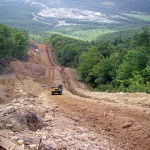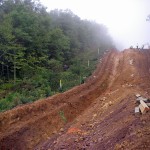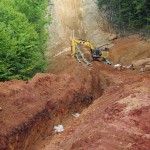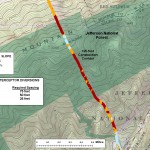- South side – corridor
- South side – open trench
- South side – swale
- Corridor slope analysis
Uncontrolled Runoff on Steep Construction Corridors
Chapter 3.11 of the Virginia Erosion and Sediment Control (ESC) Handbook provides standards and specifications for prevention of downslope runoff across “disturbed rights-of-way and similar sloping areas.” Right-of-way diversions, also called water bars or water interceptor-diversions, are to be constructed to intercept runoff and direct it off of disturbed areas before it has a chance to concentrate and cause erosion. Requirements for spacing, design, and maintenance include:
- Temporary diversions are to be installed as soon as the right-of-way is cleared and/or graded.
- Spacing of diversions is to be based on slope steepness, with closer spacing on steeper slopes.
- The diversions are to be constructed completely across the disturbed part of the right-of-way.
- The minimum allowable height of the diversions is 18 inches.
- Diversions broken down by construction equipment are to be restored by the end of each day.
These requirements are incorporated in plans and approvals associated with the Columbia Gas of Virginia (CGV) pipeline project in the Jefferson National Forest (JNF), including the general standards and specifications submitted by CGV to the Virginia Department of Environmental Quality (VADEQ) and the project-specific ESC Plan submitted by CGV to the Forest Service. Based on slope-steepness criteria, temporary water interceptor-diversions should have been spaced at 25-foot intervals for most of the pipeline construction corridor in the JNF. The available evidence, including site photos and observations, as well as heavy sediment transport and stream sedimentation, indicates that these diversions were not properly installed and maintained during the construction phase of the project.
Waiver of Open-Trench Limitations on Steep Mountainsides
Minimum standards established for utility corridor construction by Virginia ESC regulations limit the length of open trench at any given time to 500 feet, thereby reducing the risk that an open trench will become a channel for uncontrolled storm water runoff and sediment transport. This limitation is especially important for trench excavation on steep mountainsides. CGV and other pipeline companies, however, routinely apply for and receive waivers to the open-trench limitation. The VADEQ evidently does not consider slope steepness, difficult topography, soil erodibility, or other ESC design factors when approving requests for waivers.
In the case of the CGV project, the presence of long steep slopes and difficult topography, which should argue for strict adherence to the open-trench limit, were instead cited as justification for waiving the open-trench limit. CGV requested waivers for open-trench limits for two segments of the project. A waiver allowing 1000 feet of open trench was requested for the western side of Peters Mountain based on the possibility of encountering extensive bedrock. A waiver allowing 2000 feet of open trench was requested for the eastern side of the mountain based on slope steepness and the danger associated with working downslope during excavation. Although these issues could have been addressed by appropriate sequencing of the construction project, it appears instead that a critical ESC requirement was waived in the interest of the CGV’s schedule and convenience.
In granting the waivers, the VADEQ apparently failed to consider the relative erodibility of the soil in the construction corridor. Soils information submitted by CGV described much of the soil in the corridor as highly erodible. Heavy sediment transport during the active construction phase of the project, as well as later problems with slope failures, point to the significance of this oversight.
It also seems that the VADEQ failed to carefully consider the specific configuration of the site and the design of water-interceptor diversions. Due to the placement of the trench on the down-hill side of the construction corridor, both intercepted and uncontrolled runoff from the construction corridor could only drain into and then down the open trench. Examination of the ESC Plan for the project should have revealed this problem and weighed against granting the open-trench waiver. During a rainy period, the trench became a drain for sediment laden runoff down the steep mountainside. A low place in the trench acted as trap for sediment, which either overflowed into downslope areas or was cleaned out with equipment and deposited downslope.
Further compounding the open-trench problem was apparent noncompliance with the Virginia ESC regulation which specifies that excavated material from installation of underground utility lines shall be placed on the uphill side of trenches. Photographs of the open trench on the eastern side of Peters Mountain show excavated material on the downhill side of the trench for most or all of the extended open-trench length. This improperly placed material contributed to failures of silt fences and downslope movement of sediment off the construction corridor.



